|
A Tale of Two Tigers: 1/48 scale
F11F-1 Comparo
Collect-Aire vs. Fonderie
Miniature
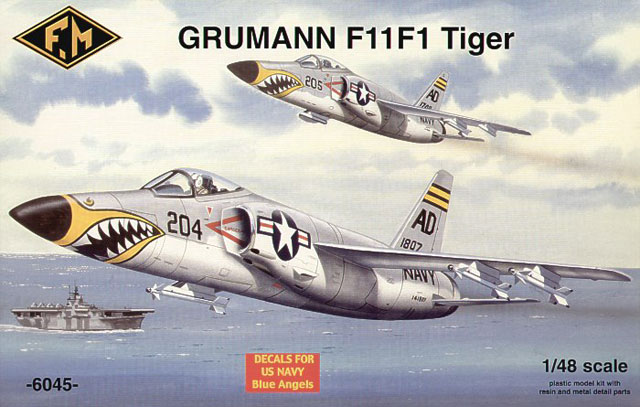
| Brand and
Description: |
Scale: |
Medium: |
Price: |
| Collect-Aire
F11F-1 Kit no. 4807 |
1/48 |
Resin including
white metal details. |
MSRP
USD$99.95 |
| Fonderie
Miniature F-11F-1, Kit 6045 |
1/48 |
Multimedia
kit (short-run injection styrene main components plus resin and white metal details). |
MSRP
USD$85.00
(available for USD$59.95 online from Squadron.com) |
by
"Bondo" Phil Brandt

Fonderie
Miniature's 1/48 scale F11F-1 Tiger is available online from Squadron
Background (There
I was...)
|
Princeton AFROTC Cadet Bondo stood at ease at the 1959 annual Spring
joint ROTC parade. It had been rumored that there was to be a surprise
appearance of some kind, and it wasn’t long in coming. As our attention
was directed up in the bright New Jersey sky, a formation of tiny black
dots passed overhead in trail. They split-essed, and soon all six sleek
Blue Angel Grumman Tigers smoked by the parade ground at very low level.
The impressive “enroute” show lasted about fifteen minutes, and then the
Blues continued on to destination. I still remember how those F11F-1
“Long Noses” had a “look” that was absolutely perfect for their role in
one of our nation’s two frontline military aerobatic teams.
Although the Tigers enjoyed a relatively short operational career,
mainly due to insufficient J65 power, their handling was honest and
quick–some say that the Tiger was the best airplane the Blues ever
flew--and the airframes were simple and tough, in the best Grumman
“boilerplate” tradition. When, later, the J79 engine was mated to a few
Tiger airframes, performance became phenomenal, approaching mach 2.2.
Kit Chronology
In the past ten years or so, modelers desiring a 1/48 scale Grumman
Tiger had but two choices: a) an injected, Fifties-era, somewhat
toylike Lindberg “short nose” or b) the Collect-Aire (C-A) all resin
“long nose.” To convert the inexpensive Lindberg release into a
definitive “long nose” was documented in, I believe, FSM; it’s not an
easy project.
The Collect-Aire resin release, one of the earlier ones in their
eclectic line (but still in production), features engraved panels, cast
metal gear, gear doors and main cockpit components. Additional details
are a vacuformed canopy and separate speedbrakes, refueling probe and
tailhook.
Enter the just-released Fonderie Miniature (F.M) limited edition,
injected “long nose” with resin details, cast metal gear, photoetch and
vacuformed canopy.
Now it’s a whole new ballgame.
Scale Fidelity
The overall length of the C-A fuselage assembly is approximately ½"
shorter than that of the F.M, that is, two scale feet.
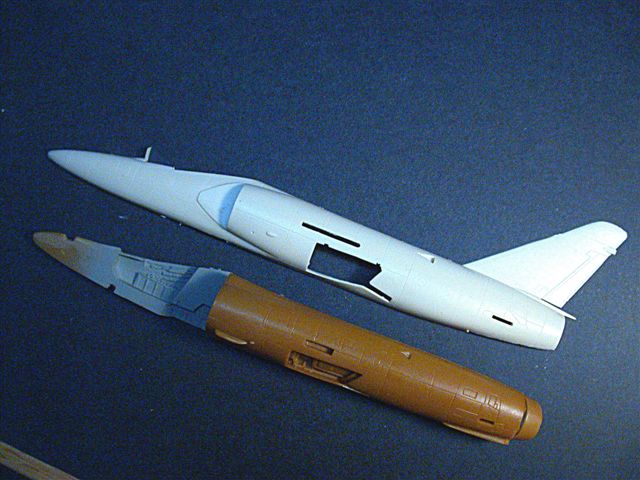
The F.M fuselage overlays exactly the line drawings from the Vol 10
Issue 11 (October 2004) line drawings in SAM. Wings from both kits match
the SAM drawings, but the span of each C-A stabilator is roughly 1/8"
(six scale inches) shorter than shown in the SAM drawings.
Molding
C-A: The fuselage aft of the intakes is typical of many
early resin kits. That is, it’s a monolithic chunk of caramel-colored
resin (with a prominent raised casting seam down the centerline), so
heavy that Bondo’s floor-standing drill press with a 5/8" bit was used
to remove a significant amount of the internal stuff; talk about piles
of shavings! The forward fuselage is split lengthwise with separate
intakes. Cockpit sidewall detail is molded in. Wings, stabs and
vertical fin are individual one-piece assemblies, although you’ll note
in the pix that Bondo Industries employees chose to create separate
slats and flaps. Maingear bays, forward and aft (that’s right!, forward
and aft !)speedbrake bays and the tailhook housing are all cast into the
main fuselage. The refueling probe cavity is cast into the right
forward fuselage half. Engraved panel lines are on the heavy side for
this scale, especially the fuselage, but not as bad as Matchbox. The
aforementioned bays are somewhat roughly executed, but with speedbrakes,
gear and gear doors installed, it would be difficult to notice. Overall,
details are somewhat soft.
F.M: Injected components feature petite engraving equal to
most big name brands. Overall, molding is very crisp, but with moderate
flash characteristic of limited-run injected models. The flash on
wing-half trailing edges is particularly annoying. No worries re
speedbrake and refueling bays; there aren’t any! Three separate resin
gear bays and the cockpit tub/seat are very sharply executed. Fuselage
halves, unlike the C-A kit, are complete and, of course, hollow. That
is, the forward (cockpit/nose) section, intake and vertical fin is
integrated with each fuselage half.
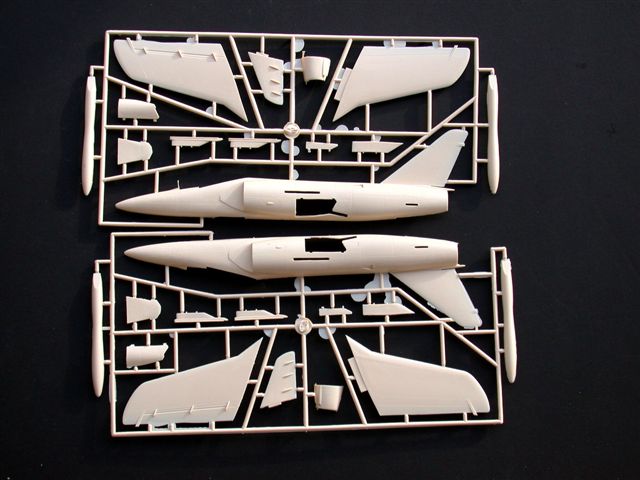
Details
C-A: Because of the kit’s solid main fuselage, tailpipe
“depth” is a minuscule 1/4", while the F.M Tiger, with the hollow
fuselage, features a two-piece assembly with much more realistic depth,
approximately 1 ½". Although the cast-in, raised detail in the C-A
cockpit sidewalls provides (pour moi, at least) not-bad realism, the
cockpit floor--same with the roof of the nosegear bay–needs to be
fashioned from plastic sheet to blot out the ugly seam running down the
center of the fuselage halves. The C-A instrument panel is cast metal,
and somewhat crude inasmuch as the rows of instruments are “wavey.”
The C-A kit casts in some aft canopy detail on each forward fuselage
half and adds a PE piece to the aft canopy. Their vac’ed canopy isn’t
bad, but has some waviness on the sides; just not as crisp as that of
the F.M. The four cannon housings on the bottom of each intake stand too
proud of the intake, and there is no representation of the cannon
barrels.
F.M: For a non-cheapo kit (only 15% less than the
expensive C-A release), it’s surprising to see the lack of any
speedbrake and refueling probe detail. However, the resin details that
are included are first rate. The PE panel used by F.M is much sharper
and precise.
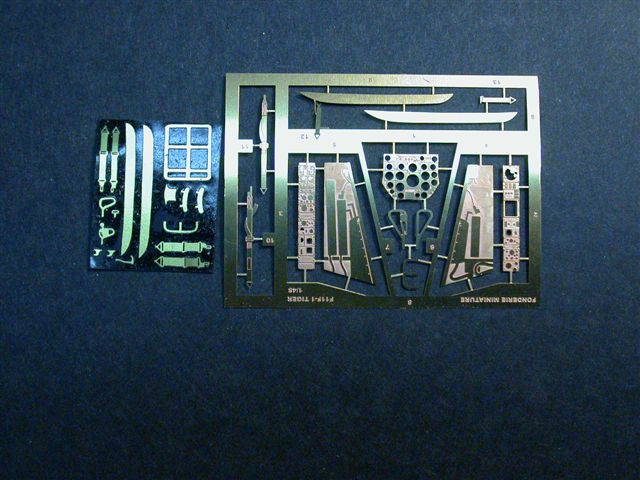
PE side panels on the F.M aren’t bad, but by their very nature don’t
give quite the same artistic effect IMO as the raised emphasis of the
resin C-A ones. The cannon barrels are correctly blended with the
intakes, and there are representative cannon barrel depressions.
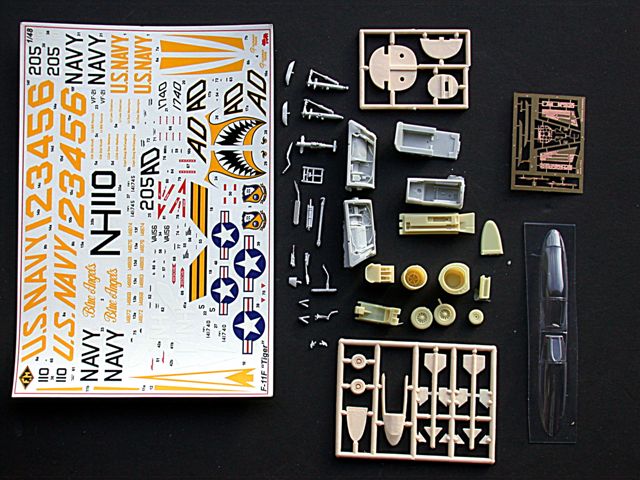
Multi-piece resin, vacuformed (very smooth, thin and clear) and cast
metal canopy components for the F.M kit are excellent.
Click the thumbnails below
to view larger images:
Cast Metal
C-A: It’s good that the gear struts are cast metal
because, as I’ve said above, without the services of a drill press, this
model is one heavy sucker! Casting detail is not bad–the gear struts are
nicely “busy”--but, along with the other metal parts, will need some
needle file cleanup. I’m still mystified as to why the seat, instrument
panel and gear doors were not done in resin.
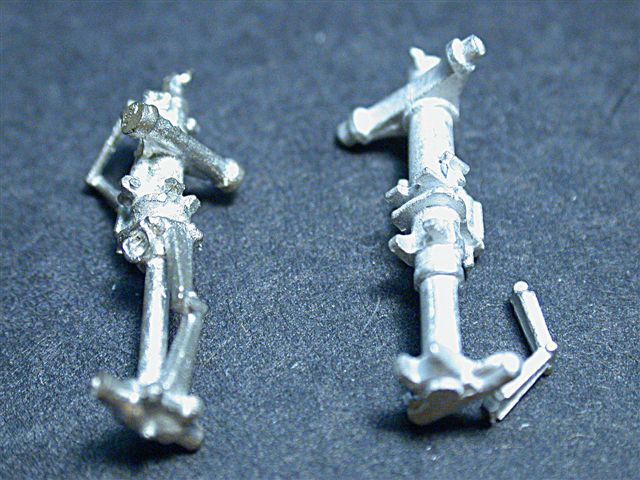
F.M: No surprises with the large quantity of cast metal in
this kit; the French model manufacturers seem to be infatuated with the
medium! This is not to say that the metal parts are substandard. In
fact, they’re excellent overall, somewhat more “finished” (read smooth,
with a seeming glass-beaded flat finish) than those of C-A.
Click the thumbnails below
to view larger images:
Externals
C-A: This one’s easy; there ain’t none, and I mean
none! No pylons, no missiles, no tanks.
F.M: Two missile pylons and AIM-9s, plus two area-ruled,
supersonic fuel tanks and correct pylons. Gotta say, though, that out of
the more than one hundred B&W pix in the authoritative Ginter Naval
Fighter book, there are only two shots of fitted tanks, and neither is
of operational unit aircraft.
Decals
C-A: Quite decent Invisa-Clear markings for one
operational squadron (the well known VF-21 shark’s teeth) and Blue Angel
Lead. Thinness, registration and color are right on the mark. A few
stencils.
F.M: A large sheet with markings for two operational units
as well as for all six Blues. Lotsa stencils, too. Decals are thin, and
registration is good. Color is also excellent, with two glaring
exceptions, the blue shade in the U.S. national insignia, and the jet
intake warning stripes. I don’t know why these outfits can’t get the
deep blue right. Instead, it appears that F.M’s decal vendor has used
the lighter blue of the French tri-color. The red intake stripes are way
too orangey.
Instructions:
C-A: The traditional yellow booklet with the,
unfortunately, traditional simplistic assembly drawings. Nice line and
detail drawings and historical text, all seemingly gleaned from aviation
mags such as Airpower and Wings and the Ginter book. One page showing
decal placement and color division.
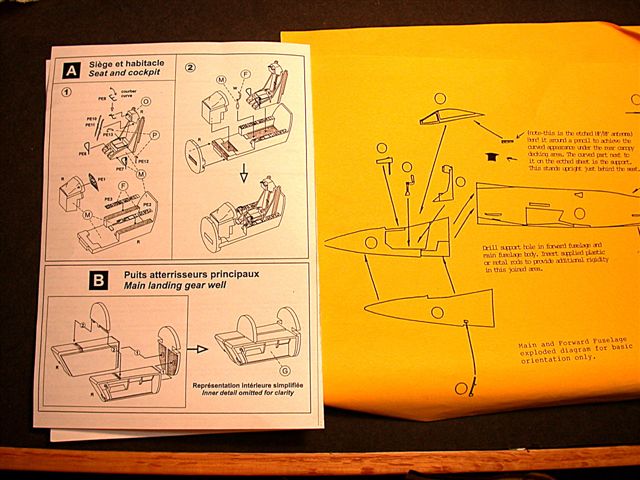
F.M: Eight smaller pages of very decent computer-generated
assembly blow-ups and perspective sub-assembly detail drawings. It would
be very difficult to screw up things by following these pages. Four
additional large B&W pages of color schemes, markings and stencil
placement.
A proper evaluation has to include the knowledge that the
hard-to-produce resin C-A kit is at least ten years old and, for its
time, was IMO a quite decent effort, albeit expensive, and certainly not
close to shake-and-bake. The slightly less expensive F.M kit is quite
superior in molding, ease of assembly and resin add-on details. That
said, not only does it lack the additional speedbrake and refueling
details standard in the elderly C-A kit, but, in a present day $85 kit,
I would expect to see at least positionable slats and flaps, ala
Trumpeter.
Even with these criticisms of the latest F.M release, I would have to
say that the $100 C-A kit has seen its day and been decidedly eclipsed.
In this curmudgeon’s opinion, it’s now of value mainly to collectors.
Review and Images Copyright © 2005 by
"Bondo" Phil Brandt
Page Created 19 December, 2005
Last updated 19 December, 2005
Back to HyperScale Main Page
Back to Reviews Page
|
Home | What's
New | Features
| Gallery |
Reviews | Reference
| Forum
| Search